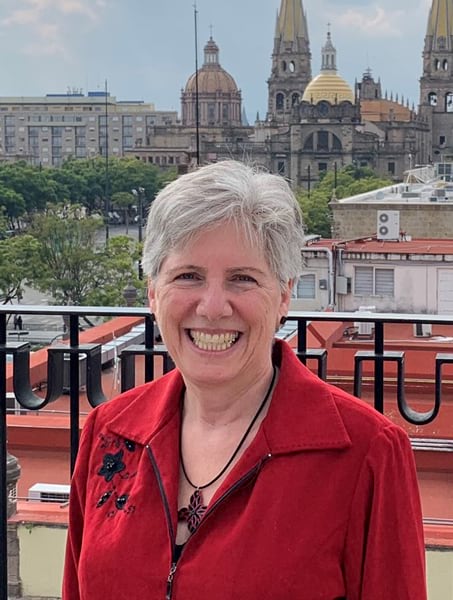For a relatively recent self-taught GIS practitioner, Dr. Charlotte Smith has had quite an impact on the GIS education community.
A faculty lecturer at the University of California (UC), Berkeley, and visiting professor at the Instituto Tecnológico y de Estudios Superiores de Occidente (ITESO) in Guadalajara, Mexico, Smith teaches GIS courses that incorporate her background in public health and environmental health sciences in a truly integrated way.

“It’s a thrill to see students come to understand the power of including location in statistical analyses, visualizing data, and telling stories,” Smith said. “They’re learning GIS techniques, but in the end, it’s all about what they can do with the technology and how they can use the information for advocacy and making the changes they want to see.”
Smith hasn’t always been an educator, and her forays into GIS began only about seven years ago. But she started writing GIS curricula almost as soon as she finished her first set of Learn Lessons from Esri Training and quickly immersed herself in the GIS education community.
“What drew me in and keeps me in the world of spatial analysis is the community aspect,” she said. “GIS is very much about community, and this community can really keep you motivated.”
Smith describes her career as being like one of Dutch graphic artist M. C. Escher’s famous lithographs, “with the steps going in all directions and people going up and down at the same time,” she said.
She majored in microbiology at the University of Michigan and stayed on as a research scientist in the Department of Microbiology and Immunology. From there, she went to Columbia University to do similar work as a molecular biologist.
Then, it seems, her insatiable curiosity and limitless desire to learn took over when she got the idea to get more involved in community health work. Smith became interested in health promotion in local community settings, so she decided to get a master’s degree in community health from Brooklyn College. She believes that getting more education and acquiring credentials is the best way to make a career change.
Smith finished her degree, but she never ended up fully working in that field because, by happenstance, a new interest came into the picture.
“During my master’s degree, I got an internship at the New York City Water Department, which turned into a job, which turned into a career in the drinking water sector,” she said. “This is why I tell students, never say no to an opportunity. You don’t know what you’ll make of it or what it will turn into.”
Smith found the work fascinating, especially when it came to evaluating water quality.
“People turn on the tap, and they think that’s it; it’s fine,” she said. “But we can see now with Flint, Michigan, and the recent water crisis in Jackson, Mississippi, that clean water should not be taken for granted. If it were easy, those problems would have been solved in a few hours. It takes technical know-how, political will, financing, regulations, and operator training to ensure good quality drinking water.”
Smith spent six years at the New York City Water Department before becoming director of water quality for a French company that owned and operated 35 drinking water utilities in the United States as well as others around the world. In this phase of her career, she focused on solving water quality problems and developing regulatory compliance programs. When the American subsidiary was sold, she had the choice to either join the purchasing company or not.
“I chose not,” she said. “And when you choose ‘not,’ you have an opportunity to do something new and better.”
That’s when she founded Charlotte Smith & Associates, Inc., a consulting firm that helps utilities all over the world improve water quality. For almost 30 years, she has conducted evaluations of water systems and trained water distribution system operators to find and solve water quality problems, among many other jobs.
In the middle of all this, Smith decided to go back to school to pursue her PhD. She’d heard that Legionella, the bacteria that causes Legionnaires’ disease, lives inside protozoa and avoids digestion and, thus, destruction.
“I thought that was one of the most interesting things I’d ever heard in my entire life, and I wondered what else does that,” said Smith. “Well, nobody was going to pay Charlotte Smith & Associates to find out.”
So she obtained a Science to Achieve Results (STAR) research grant from the Environmental Protection Agency (EPA) and entered a PhD program at UC Berkeley to answer this question. She studied two bacteria—H. pylori, which causes stomach cancer, and E. coli, which causes diarrheal disease—to see if they can survive digestion in protozoa.
“The answer is no for H. pylori and yes for E. coli,” said Smith. “I was happy because I had my answer.”
According to Smith, that’s how a doctoral dissertation should play out.
“You should have an obsession with a question,” she said. “If you have that, then go back to school, take some time, answer the question, and move on with your life.”
Smith did move on with her life. After she answered her question, she took on an entirely new role in academia, teaching the courses Environmental Health Sciences and Drinking Water and Health at UC Berkeley in the School of Public Health. She kept running Charlotte Smith & Associates (and still does). Additionally, this new stage of her life gave her time to explore a technology she’d gotten curious about: GIS.
“I just did a whole bunch of Esri’s Learn Lessons,” she said. “They’re amazing. They’re perfect for independent study because almost every step has an image, so you know that you’re on the right track.”
Through the Learn Lessons, Smith developed an appreciation of GIS in public health and environmental health sciences.
“GIS helps us understand the full picture,” she said. “As I got more and more into mapmaking and spatial analysis, I created four GIS courses. I eventually dropped the courses I was teaching, and now it’s all GIS all the time. I’ve become a GIS zealot.”
Her students have used GIS to map the locations of drinking fountains throughout Berkeley to help the city promote the consumption of water rather than sugary beverages. The students have employed ArcGIS Survey123 to gather data about campus restrooms to help ensure that the university has accessible and gender-inclusive bathrooms. They’ve used Survey123 to collect quantitative and qualitative data on access to safe drinking water in Guadalajara and in rural communities on Lake Chapala, Mexico. Smith teaches her students how to use Esri technology, such as ArcGIS Online, ArcGIS Dashboards, and ArcGIS StoryMaps, as well as how to conduct geospatial analysis.
“I’m amazed at what these students can create in such a short amount of time,” Smith said, referring to her eight-week and semester-long courses.
While Smith has been teaching GIS to undergraduate and graduate students for about five years, she had never taken a formal university course in GIS until last year. Ever the lifelong learner, she enrolled in Johns Hopkins University’s Master of Applied Science in Spatial Analysis for Public Health program.
“Because I had never taken a GIS course, I had no role models for the pedagogy,” she said. “The way I’ve been teaching GIS is based on the way I’ve taught other courses. But I questioned whether that’s the best way to teach GIS.”
Learning from the Johns Hopkins faculty and students, Smith says she’s not only becoming a better professor by participating in the program, but she’s also learning to approach projects in different ways.
“The GIS community is full of people who are willing to share, communicate, and support one another,” said Smith. “As a person with a neurodegenerative disease and limited mobility, being part of the GIS community sustains me.”

